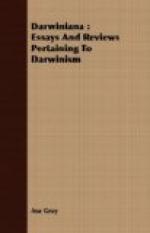“The cause which attracts flies is evidently a sweet, viscid substance resembling honey, secreted by or exuding from the internal surface of the tube . . . From the margin, where it commences, it does not extend lower than one-fourth of an inch.
“The falling of the insect as soon as it enters the tube is wholly attributable to the downward or inverted position of the hairs of the internal surface of the leaf. At the bottom of a tube split open, the hairs are plainly discernible pointing downward; as the eye ranges upward, they gradually become shorter and attenuated, till at or just below the surface covered by the bait they are no longer perceptible to the naked eye nor to the most delicate touch. It is here that the fly cannot take a hold sufficiently strong to support itself, but falls. The in. ability of insects to crawl up against the points of the hairs I have often tested in the most satisfactory manner.”
From the last paragraph it may be inferred that Dr. Macbride did not suspect any inebriating property in the nectar, and in a closing note there is a conjecture of an impalpable loose powder in S. flava, at the place where the fly stands so unsteadily, and from which it is supposed to slide. We incline to take Mr. Grady’s view of the case.
The complete oblivion into which this paper and the whole subject had fallen is the more remarkable when it is seen that both are briefly but explicitly referred to in Elliott’s book, with which botanists are familiar.
It is not so wonderful that the far earlier allusion to these facts by the younger Bartram should have been overlooked or disregarded. With the genuine love of Nature and fondness for exploration, ’William Bartram did not inherit the simplicity of his father, the earliest native botanist of this country. Fine writing was his foible; and the preface to his well-known “Travels” (published at Philadelphia in 1791) is its full-blown illustration, sometimes perhaps deserving the epithet which he applies to the palms of Florida—that of pomposity. In this preface he declares that “all the Sarracenias are insect-catchers, and so is the Drosera rotundifolia. Whether the insects caught in their leaves, and which




